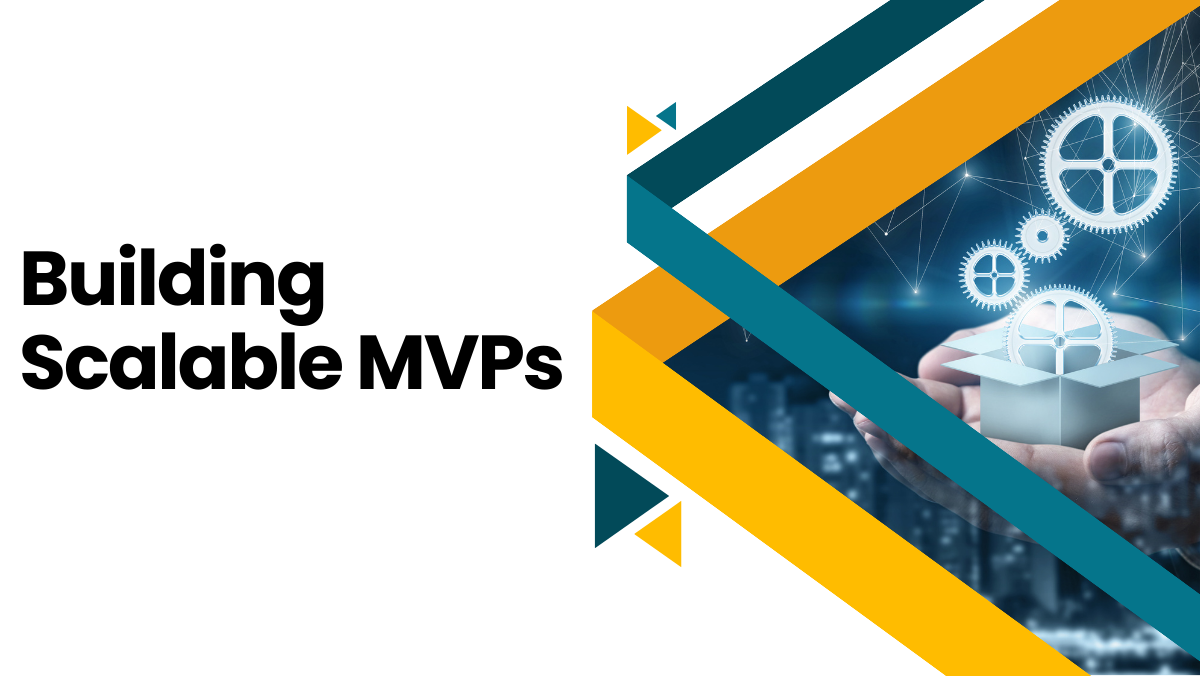Building Scalable MVPs: Best Practices and Common Pitfalls

It’s very difficult to design an MVP that is both functional and scalable for startups and established companies. An MVP, when well done, helps a team validate its product idea with the minimum use of resources while receiving feedback from users on how it can be made better; it lays the grounds for scalability but requires careful research, strategic data collection, and presentation.
Research and Data Integration
Initial Research
The basis of creating a scalable MVP is through extensive research on existing methodologies and the identification of common challenges.
Exploration of the existing literature: The existing literature and articles have a common problem related to the scalability issue of MVP development. Most start-ups face a problem with designing the MVPs scalable with rapid growth in users without requiring major overhauls. Such information is helpful in anticipating possible problems and their mitigation.
Identifying gaps: Despite ample literature available on MVP, still many areas remain unexplored. For instance, the lack of clear guidelines in switching over from MVP to a full-fledged product leaves teams to improvise over that critical phase.
Referencing frameworks, one of which is the Lean Startup methodology and Agile processes. It outlines a systematic approach toward developing MVPs.
The Lean Startup methodology involves rapid experimentation and learning, and the same elements play a significant role in developing an MVP. Agile processes involve iterative cycles that ensure continuous improvement and scalability.
Data Collection
Real-life examples and industry experts’ feedback gather data regarding how an MVP is successfully designed, its feasibility, and its scalability.

- Case Studies of Successful Scalable MVPs: A couple of good examples to learn from are companies like Dropbox and Airbnb. Dropbox started with just a video demo and could so effectively convey its value proposition, that it gained early adopters, thereby serving as the grounds for validating the concept before going about full-scale development. Maxiom Tech
- Similarly, Airbnb started with a basic website to validate the market demand for short-term rentals. In this manner, they could fine-tune their platform based on user feedback. Fueled
- Insights from Interviews: Discussions with the founders of startups and product managers often bring to the fore firsthand experiences when developing an MVP. Many stress the core functionalities and being prepared to pivot based on user feedback. For example, founders often point out the need for adaptability when initial assumptions are challenged by the realities of the market.
Statistics on MVP Failure Rates and Scalability Issues: Industry reports note that most MVPs do not scale very well. Poor architecturing of the initial product, ignoring feedback from users, and a lousy scaling plan are some general causes of such failure. All these statistics reflect the importance of strategic planning in the development of an MVP.
Implementing Research and Data Integration

Integrating the insights, in terms of research and collection of data, in the process of developing an MVP involves several strategic steps:
- Applying Lean Startup and Agile Principles: It is the development cycle applied in iterations that supports the team in building, measuring, and learning fast. Entire development cycle allows rapid prototyping to continually improve toward the scalably MVP.
- Learning from Case Studies: One might draw on the experience of companies like Dropbox and Airbnb building an MVP. One could, for example, avoid overinvestment in ideas that haven’t yet been validated by starting with a very simple core feature set and then validating the idea through early adopters.
- Engaging with Industry Experts: Seeking advice from experienced founders and product managers can provide practical insights and mentorship. Their experiences can guide teams in navigating challenges and making informed decisions during the MVP development process.
- Utilizing Visual Tools for Planning: Infographics, charts, and comparison tables may be useful to indicate where the risks may come and clear development milestones need to be set in the planning phase. The devices will assist team members in understanding and agreeing along with best practices and pitfalls.
Scalability is very important in the development of MVP to allow smooth transitions from idea to full-scale operations for a startup. The MVP forms the core version of the product, and with few resources, it allows one to test central ideas. However, when scalability is not built early on, it is going to create major headaches as the startups scale up.
Why is scalability important in an MVP?

Scalability ensures that an MVP can grow without necessarily having to redesign it entirely. By incorporating scalability into the MVP, startups can handle growth in user demand and feature enhancement seamlessly, thus facilitating sustainable growth.
Why do many startups struggle with scaling their MVPs?
Several common pitfalls contribute toward this challenge:
- Inadequate Market Research: Without proper market validation, this MVP may result in inappropriate products that are not geared toward user needs and then cannot scale. Innovify
- Overcomplication: Too many features in an MVP make it difficult to scale and shift focus away from the core value proposition. Lean Labs
- Neglecting User Feedback: Ignoring initial user feedback may lead to products that aren’t connected with the ideal customer, which hampers growth. MobiTouch
This blog is going to dive deeper into the best practices for developing scalable MVPs and common pitfalls to avoid, which helps startups better know how to build growth-ready products that are solid.
Note: The information provided is based on industry insights and common challenges faced in MVP development.
We used a multi-stage methodology for research to carry out an in-depth analysis of building scalable MVPs.
- Case Study Analysis: We looked at a real life implementation of successful MVPs, namely Dropbox and Airbnb to identify those strategies that allowed them to scale. The case study provides real life insights to develop a good MVP. Maxiom Tech
- Review of Industry Frameworks: We discussed best practices, including the Lean Startup approach, which emphasizes fast experimentation and learning during development to quickly produce products that meet customers’ needs in a timely manner.
The Lean Startup
Assumptions:
- Familiarity with MVP Concepts: It is assumed that the readers have a basic idea about MVPs. Therefore, it is defined as an early version of the product with enough features to attract early adopters and validate a product idea. Investopedia
- Awareness of Lean Startup Principles:We assume that the readers know about the Lean Startup approach in designing products, for which customers have already shown their demand and are granted once they are launched into the market. Investopedia
This methodology combines insights from industry professionals with the theoretical frameworks, thus giving a holistic view on critical factors that affect the scalability of MVPs.
The final step for validation of an idea and the actual witnessing of success is when built into a scalable MVP form. The perfect example is dropout and Airbnb, and an MVP built will start an MVP scaling up to lead to success.
Key Best Practices:

Start with a Well-Defined Problem Statement:
- Clarity of Purpose: Clearly state specific problems that your product intends to solve. This ensures all development work is aimed towards solving real needs of actual users.
- Target Audience Identification: Identifying who faces the problem allows creating solutions that target the relevant audience.
- Focus on Core Features that Solve the Primary User Problem:
- Simplicity: Focus on core functions that directly solve the problem, to avoid feature creep that water down the value proposition of a product.
- Resource Efficiency: As the resources are on the key features, the launch becomes faster, and also, the feedback from the users reaches early.
- Ensure a Flexible Tech Stack that Supports Scaling:
- Scalability: Choose technologies and architectures that can scale up to accommodate growth, avoiding the need for complete overhauls as demand from users grows.
- Modularity: In modularity, the design would ensure the feature of updating or even integrating new features without disturbing existing systems.
- Validate through User Feedback Loops and Quick Iterations:
- Continuous Improvement: Regularly collecting and analyzing user feedback enables iterative enhancements, ensuring the product evolves in line with user expectations.
- Agility: Iteration with pace based on feedback provides rapid response to market requirements and shifting trends.
- Use Cloud Solutions (AWS, Azure) for Seamless Scaling:
- Infrastructure Flexibility: Cloud services can be used to scale resources upwards or downwards, depending on the demands required for optimal performance at varying levels of usage.
- Cost-Effectiveness: Cloud platforms have pay-as-you-go models, which helps a startup manage expenses while scaling operations.
This means that through these best practices, startups are able to come up with viable MVPs, ready for smooth scalability, and set the ground for long-term success.
A Minimum Viable Product (MVP) is a strategic approach that startups can apply to test their ideas in the most minimum resources possible. However, there are several common pitfalls that may derail the scalability and success of an MVP.
Avoid These Pitfalls That Derail MVP Scalability

Overloading the MVP with Unnecessary Features
- Feature Creep: Adding too many features dilutes the core value proposition of an MVP, making it bulky and less user-friendly. Too much complication leads to too much development time and makes it costly, with reduced focus on the specific problems the product is aimed at solving.
- Solution: Focus on the key functionalities that solve the main user problem. Use techniques like the MoSCoW method, which entails Must-have, Should-have, Could-have, and Won’t-have, to keep the focus on what is critical.
Poor Architecture Choices Leading to Scaling Bottlenecks
- Technical Debt: A rigid or weak tech stack causes scalability issues when the user base grows. Architectural decisions early on that do not envision growth will eventually lead to bottlenecks, and then it is very costly and time-consuming to redo the architecture.
- Solution: Spend more time up front on design to create architecture that is scalable and flexible. Leverage best-of-breed technologies and frameworks for scalability and, when appropriate, take advantage of cloud-based solutions with on-demand resource allocation.
Ignoring User Feedback and Market Validation
- Disconnected Development: In the absence of user feedback on a product, the consequence could be a product not relevant to the target audience and therefore adoption rates can be very low. An MVP may not satisfy the actual needs of the users without market validation.
- Solution: Get insights and validate assumptions by having continuous feedback loops with users. Have the product validated by early adopters as it iteratively matches up with the exact requirements of the market.
Focusing on Aesthetics Over Functionality
- Misplaced Priorities: A pretty design is vital, but prioritizing aesthetics over the functionality core results in an MVP that is a pretty face but doesn’t solve the user’s core problem. This kind of misalignment might lower the user’s satisfaction and retention.
- Solution: It should deliver on its basic value proposition before enriching on visual design elements. Aesthetics should follow function for a well-performing product.
Underestimating Future Resource Requirements
- Scalability Challenges: Failure in prefiguring resources to scale brings about performance degradation and an inability to meet user demand. A failure in prefiguring might hurt your product, which will likely lead to stagnation as well. F22 Labs
- Solution: Scalability planning includes the estimation of the resource availability, including server capacity and database management, customer service. Then, take advantage of cloud services, which offer scalability. F22 Labs
By being aware of these pitfalls and implementing the suggested solutions, startups can enhance the scalability and success potential of their MVPs, paving the way for sustainable growth and market relevance.
We are working with Fx31 Labs on MVP development and support to start-ups.
Best Practices Implementation:
- Client Collaboration: We collaborate with our clients to identify the core features of their products so that the MVP meets the key needs of the users and business objectives.
- Scalable Solutions: Our team emphasizes building scalable architectures for MVPs, selecting flexible tech stacks that can accommodate future growth and adapt to increasing user demands without requiring a complete system overhaul.
Avoiding Pitfalls:
- User-Centric Design: We center on feedback from the end-users throughout the whole development process by using a user-centric design. This ensures that the MVP resonates with the audience, enhances user satisfaction, and engagement.
- Strategic Scaling: MVPs is based on validated learning, which relies on data-driven insights for informed feature enhancement and market expansion. This will do away with premature scaling and misuse of resources.
That way, we enable startups to grow and develop their robust, scalable MVP with a high chance to compete in the competitive world of technology.
The essence of MVP development will involve a strategic balance of simplicity and flexibility in its architecture. This means having all the most important features but being able to remain highly flexible.
Key Insights:
- Balancing Simplicity with Flexibility: Focus the core functionalities while designing it flexible enough to be highly scalable as user demands fluctuate. This design never gets into the mess created by over-engineering a product, keeping it totally user-centric.
Practical Recommendations:
- Conduct Regular Scalability Tests:
- Purpose: It will indicate regular testing where there are possible bottlenecks, thereby determining possible issues in handling more loads.
- Implementation: Use appropriate tools and methodologies to simulate diverse user loads and monitor performance. Identify and correct these issues promptly to ensure optimal operation.
- Prioritize a Modular Architecture:
- Purpose: Modular design breaks the system into independent modules that make it easier to maintain and scale. This module structure enables focused updates and resource management.
- Implementation: Develop the MVP with modules that can be modified or expanded without disturbing the entire system. It helps in parallel development and facilitates easier
Motivational Note:
The journey of MVP development is that of learning and adaptation. An MVP, both simple and flexible, will help form the basis on which a product can grow in consonance with the vision and evolving demands of the market.
You have to be open to iterative development, responsive to the feedback from your users, and forward-looking about scalability. That attitude will help your product grow sustainably and thrive under dynamic market conditions.
Develop a scalable path through being very detailed in design, frequent testing, and commitment to modular design. This is a step that will help you position your product for long-term success as it adapts to the ever-evolving technological environment.
Note: The following are based on industry best practices and general guidelines for MVP development.
Ready to take the next step? Contact us for a free consultation, and let’s discuss how we can help your business thrive with our innovative solutions.
For more details, visit our website (MVP Development for Startup support – Fx31Labs) and discover how we can support your business with our tailored solutions.
